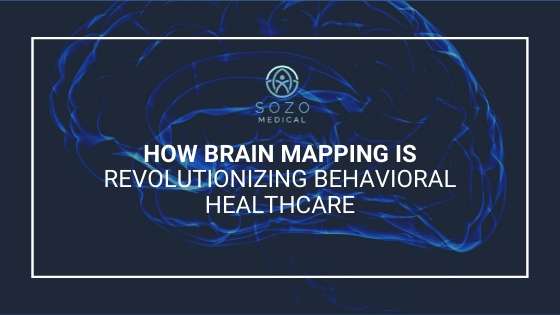Article Contents
Addiction and mental health conditions are typically treated through behavioral therapy, education, medications, and the development of healthy coping mechanisms. However, sometimes underlying issues are difficult to diagnose when doctors are unable to physically see them on a chart. Fortunately, a new innovative and technologically advanced way to identify inconsistencies in the brain has been developed. Non-invasive and extremely effective, brain mapping has begun to revolutionize mental health counseling and addiction treatment programs across the country. By definition, brain mapping is the study of the anatomy and function of the brain and spinal cord through the use of imaging, immunohistochemistry, molecular & optogenetics, stem cell and cellular biology, engineering, neurophysiology, and nanotechnology. In other words, this tool is extremely effective in identifying imbalances in the brains of patients who suffer from mental health conditions and/or substance use disorder.
After identifying problematic areas of the brain using brain mapping techniques, trained medical health professionals can then begin neurofeedback. Neurofeedback, or EEG biofeedback, is the process of balancing and regulating chemicals in a patient’s brain. Simply put, doctors begin by creating a brain map for an individual patient to identify chemical imbalances. They then begin neurofeedback processes in order to regulate problematic areas of the brain. This allows mental health and addiction treatment patients to receive proper treatment of their specific ailments, rather than a generalized treatment plan that may not suit their individual needs. Therefore, brain mapping has begun to revolutionize the way we conduct mental and behavioral healthcare in the best way possible.
What is Brain Mapping & How is it Related to Neurofeedback?
Brain mapping is only conducted by licensed medical professionals who are knowledgable and trained on the procedure. While this tool is non-invasive, doctors must be able to read complicated brain waves and charts in order to produce accurate diagnoses of mental health conditions. Brain mapping is the act of a doctor or scientist viewing and identifying anomalies in the brain that denote a structural or functional disorder and/or malfunction. In doing this, doctors can accurately diagnose patients with mental health disorders, like schizophrenia, based on brain waves and activity, allowing them to effectively treat symptoms and prevent progression of the condition. However, using brain mapping alone will not treat anything. In fact, doctors have to use a treatment referred to as neurofeedback.
Neurofeedback (EEG biofeedback) is a non-drug reward-based treatment for chemical imbalances in the brain. This treatment works by changing electrical activity in the brain to represent a healthy flow of electrical currents and reactions. Ultimately, the goal of neurofeedback is to treat the source of unwanted physiological symptoms. For example, if a patient is suffering from panic attacks or chronic anxiety, doctors will use neurofeedback in order to regulate the chemicals in the brain that are malfunctioning and causing the individual’s anxiety. While patients may not notice an immediate change, over time, the brain is learning from the feedback and beginning to change structurally on a cellular level.
How Brain Mapping & Neurofeedback Work in Treating Mental Health and Substance Abuse
Brain mapping has become an effective and extremely attractive tool for doctors in the diagnosis and treatment of mental health conditions and substance use disorders. Brain mapping, or brain imaging, allows doctors to notice certain signs of irregular brain activity consistent with various mental disorders. Additionally, brain maps allow medical professionals to rule out certain diagnoses based on brain activity.
One of the most attractive aspects of brain mapping for patients is the fact that patients don’t necessarily have to relive traumas in order to reach a diagnosis for something like Post-traumatic stress disorder (PTSD). To explain, patients with PTSD typically undergo psychotherapy where they are made to explain their trauma in depth. While this technique is usually highly effective, it is also emotionally exhausting. On the other hand, brain mapping allows doctors to physically see signs of PTSD in the brain without the patient needing to disclose gruesome or painful details of their traumas.[1]
In regards to patients who suffer from a substance use disorder, brain mapping helps identify if the patient has a co-occurring mental illness. Oftentimes, symptoms of mental illness mirror the symptoms of addiction, leaving psychiatric disorders untreated. Individuals recovering from substance use disorder must undergo treatment for any underlying mental health conditions they have. To explain, recovering addicts or alcoholics who have untreated mental disorders are more likely to revert back to self-medicating their symptoms through the use of illicit substances. Therefore, using brain mapping technology in order to identify any underlying psychiatric disorders is vital for recovering addict’s success.
After a diagnosis is reached with brain mapping, doctors begin administering neurofeedback treatment. Medical professionals watch areas of the brain and tell the patient when their brain activity reaches an abnormal level that is specific to his or her condition. For example, a patient with depression or PTSD would begin neurofeedback treatment by being hooked up to a unique technological medical device. This device will show the patient’s brain activity on a screen, where the doctor will monitor levels of electricity in the brain. Abnormalities will show up on the screen as a different color than the rest of the brain, signaling the activity of a chemical imbalance. Once the activity reaches a normal level, the doctor will inform the patient – teaching them how to self-regulate their symptoms.[2]
Brain Mapping at Sozo Medical Group
Dealing with an untreated substance use disorder and/or a mental health condition is mentally and physically exhausting. Additionally, this is even more difficult when the individual has not reached a diagnosis for their symptoms with a licensed medical professional. Brain mapping is an innovative and technologically advanced tool used in the diagnosis of various mental health conditions, including substance use disorder. If you or a loved one are experiencing symptoms of a psychiatric or substance use disorder, brain mapping can provide you with the diagnosis and plan-of-action you need. To learn more about brain mapping and our individualized treatment plans, call us today!
References:

All of the information on this page has been reviewed and verified by a certified addiction professional.

